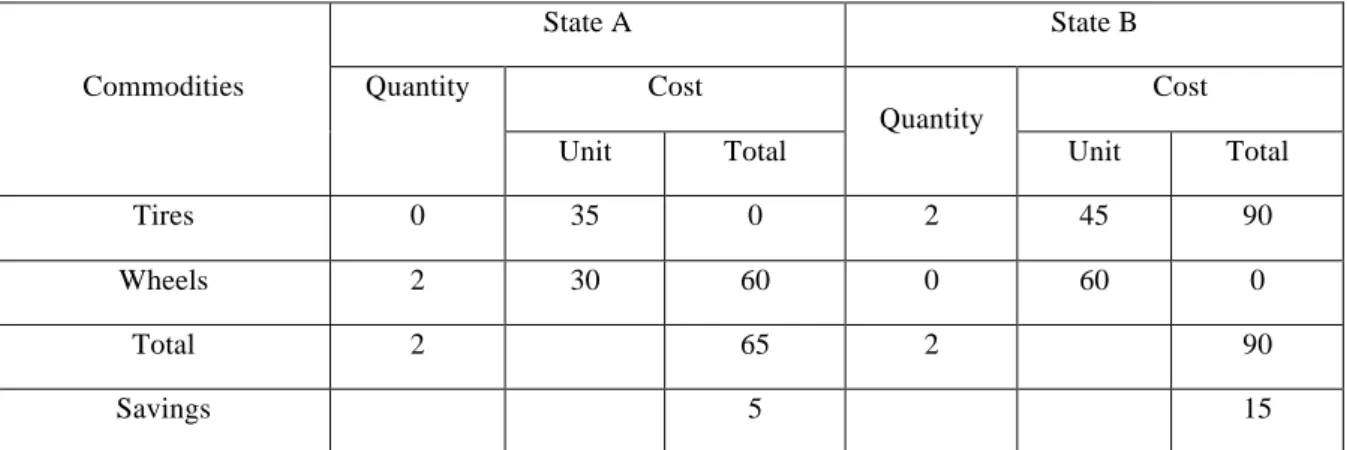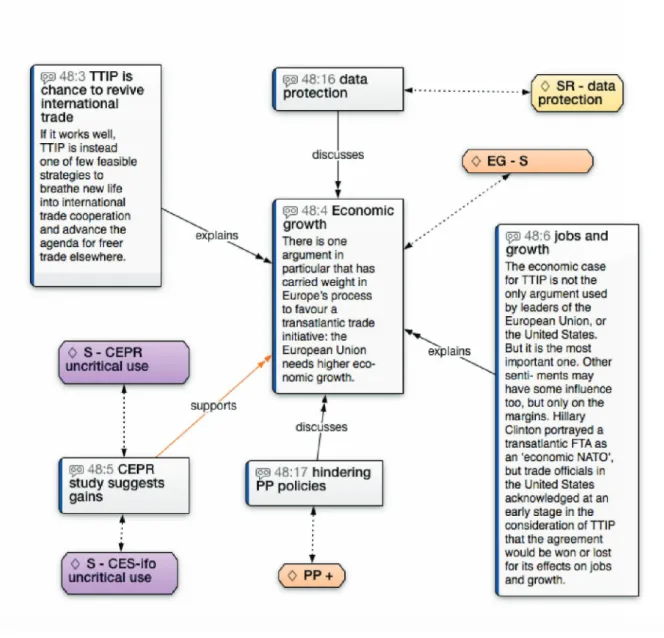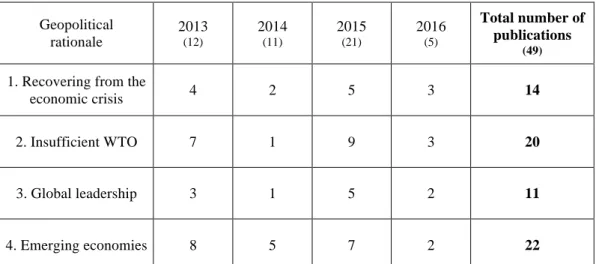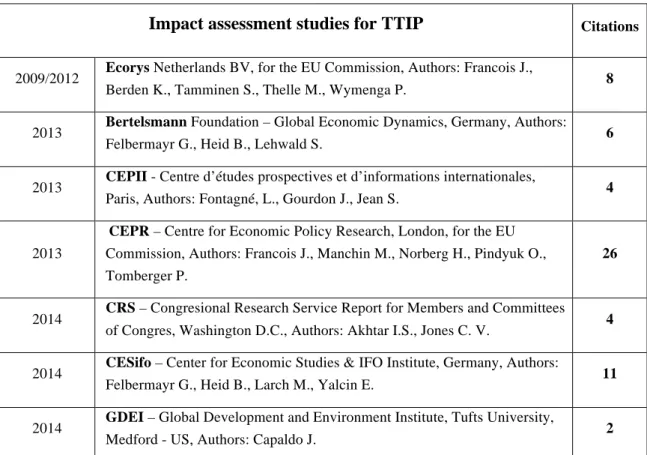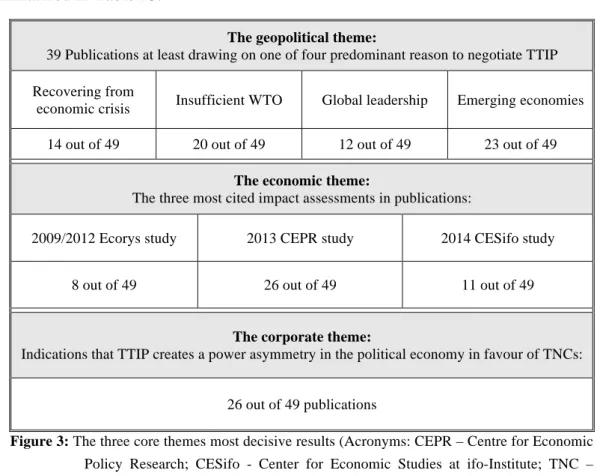The master's thesis aims to separate this twofold line of reasoning by examining evaluations published in the scientific literature. The prerequisite for answering the research questions is a better understanding of the embedding of TTIP in the global political economy.
Trade theory
It provides an introduction to free trade theories (subsection 2.1), a historical approach to the ambitions of promoting transatlantic relations (subsection 2.2), the scope of a possible agreement (subsection 2.3), and an update on the current state of negotiations (subsection 2.4). This allows the interpretation of inter-industry trade, which means that products belonging to different industries are traded (eg trade in fish and coconuts).

The history of transatlantic cooperation
Later that decade, Brittan proposed a Transatlantic Economic Partnership Agreement, suggesting that the EU and the US share similar levels of protection over areas of public interest and seek to stimulate economic growth (Brittan, s.a.). We seek to strengthen transatlantic economic integration, with the aim of improving competitiveness and the lives of our people (European External Action Service, 2007, 2)”.
The core contents of TTIP
Yet it took several years in which the EU and the US tried to strengthen transatlantic relations until they took up again the idea of a serious economic agreement. In this bloc, the EU and the US negotiate the direction of global trade.
The current state of negotiations
Considering the declared economic potentials, this is the most important negotiating block, as the approximation or reduction of these NTBs brings the highest potential benefits for the EU and the US, as classic trade barriers such as tariffs and quotas are already - with some exceptions. at a very low level between the EU and the US. Even Bercero (2016) hints that it will take much longer to reach an agreement, as there remain significant differences between the EU and the US that need to be discussed in every area of the negotiations.
The two-fold reputation of TTIP
The economic rationale (Impact assessment studies)
In the case of TTIP, the EU and the US had a potential impact on both economies, analyzed by six studies. As described in subsection 2.3, the second core strand of TTIP (regulatory cooperation block) concerns the non-discriminatory harmonization or reduction of non-tariff barriers between the EU and the US.
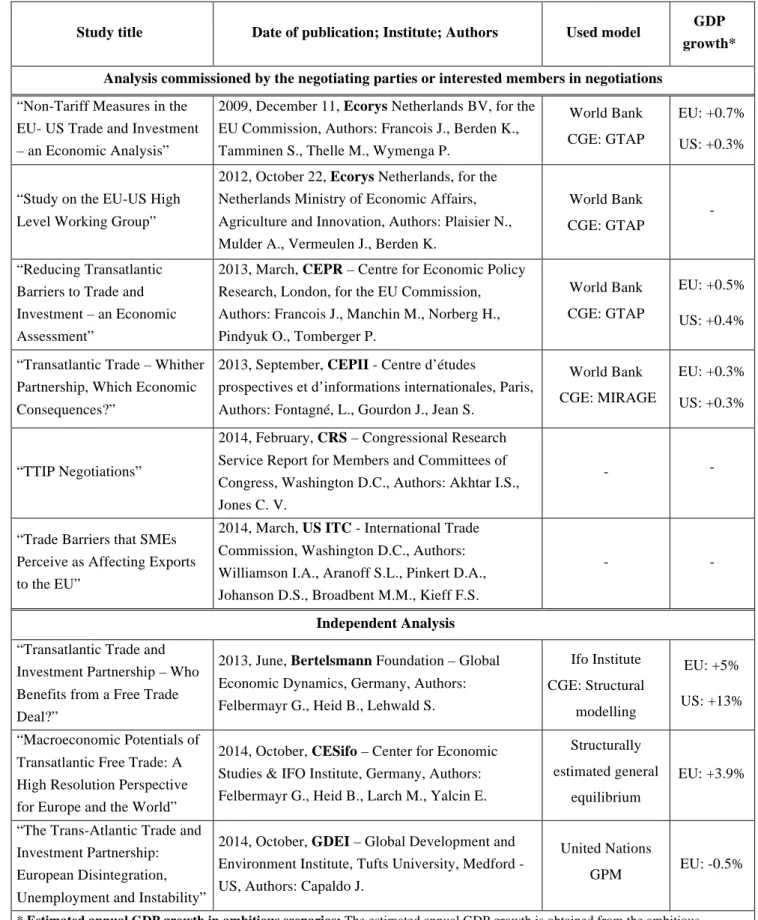
The public perception
The Wall Street Journal (2016) says that Brexit is not the first problem for TTIP. The loss of the fifth largest economy in the world (UK) is understood as an obstacle for American negotiators (FAZ, 2016).
Additional perspectives on current political, economic and scientific issues
New political direction settings (e.g. the controversial Brexit vote; political changes in Turkey) are changing the political landscape into an unpredictable state. The section begins with (3.1) a description of the basic principles of Mayring's summative content analysis, followed by (3.2) a detailed framework designed and applied by the author according to Mayring's methodology.
The theory guiding the literature analysis
Objectivity, reliability and validity are of great importance for both qualitative and quantitative content analysis. Mayring's summary content analysis can be compared to the human ability to interpret and categorize the everyday environment. It resembles a subconscious feature of human consciousness that runs automatically as the human brain has to sort and classify impressions.
In addition, the summary content analysis is further referred to as literature analysis throughout the thesis – with a view to preparedness and a better understanding of the procedure itself, as the analyzed content is technically scientific literature. This change of actual name should not be confused with a change of method.
The step by step proceeding of the literature analysis
- The determination of the research questions guiding the analysis
- The determination of the literature material
- Scientific quality
- Quality assurance: Journal Impact Factor
- Quality assurance: SCImago Journal Rank
- The determination of the theoretical analysis model
- The analysis of the literature
- The interpretation of the analysed material
The contribution is about TTIP in general or is concerned with a specific topic of it. The peer review is one of the most important quality assurances in the scientific process. As explained in Mayring's eight basic principles (in subsection 3.1), the analysis can also have such elements.
These are presented in textual and tabular form in Section 4 and represent the essential findings of the literature review. The interpretation of the analyzed material will be presented in Chapters 5 (Discussion) and 6 (Conclusion).
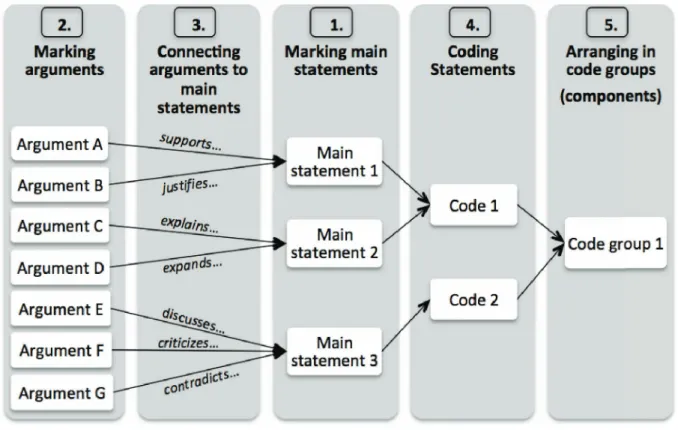
Remarks on the methodology, coverage and analysed publications The European literature is selected by the location of the institutions the authors are occupied
This network figure could be improved in various ways: By connecting to the other statements that also speak for financial gains supported by specific studies; by linking to other statements that, for example, refer to the issue of data protection; or by linking to statements from other publications that mention the benefits of the EU precautionary principle. To discuss every little aspect of the entire literature network would go beyond the scope of this thesis. A computer can undoubtedly find more objective results, but a machine is not yet capable of subsequent interpretation of the data.
This section includes the results obtained by the analyzed publications and therefore contains the insights of the analyzed literature. This is due to the type of publication, which represents a collection of contributions to one main topic.
Selected themes of the literature analysis
- Frequently mentioned regulatory issues
- The precautionary principle (PP)
- Public mistrust and transparency problems
- The identified judgement trend in scientific literature
The cultural sector of the EU should therefore not be opened to any third countries. The precautionary principle is set out in article 191 of the Treaty on the Functioning of the European Union (EU). 34;[..] the importance of engaging with civil society - such as the establishment of advisory groups, however imperfect - suggests that the EU also needs this struggle so that it can remain connected to more than just a neoliberal elite (Strange.
In (ZBW, 2014), Klodt, Klein, Bungenberg and Felbermayr express concerns about a poorly negotiated dispute settlement (ISDS) chapter of the reform proposals formulated at the time. Only a mature transatlantic agreement can ensure that the EU and the US can act as world leaders.
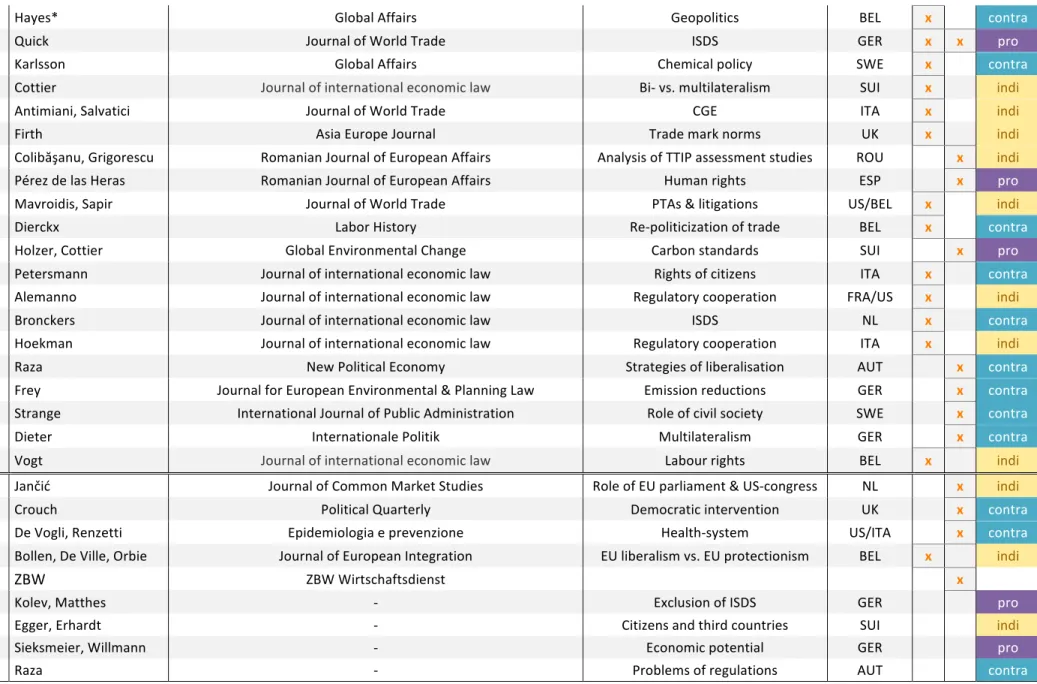
The core themes of the literature analysis
The geopolitical theme
- Recovering from the economic crisis
- Insufficient developments under the WTO
- Global leadership
- The rise of emerging economies
According to the reviewed literature, these four justifications shape the geopolitical agenda of the EU and the US. First, as more and more countries joined, the WTO has become a very heterogeneous group of countries with very different economic and political models and strategic interests (Felbermayr and Larch, 2013b, 6).” With regard to the EU and the US. to become global leaders, internal problems must be solved first.
Einige Länder können sich nicht auf ein demokratisches System verlassen, sind aber dennoch wichtige Wirtschaftspartner der EU und der USA. Darüber hinaus würde es die Wettbewerbsfähigkeit der transatlantischen Partner im Vergleich zu Schwellenländern wie China, Brasilien und Indien stärken (Mildner und Schmucker, 2013b, 72).“
The economic theme
- The Ecorys study
- The CES-ifo study
- The CEPR study
Most publications used the CEPR study to bring forward the positive effects of the transatlantic agreement. Hoekman (2013) uses the results on real aggregate earnings of the CEPR study, however noting that the predicted earnings are small. In their publication from 2013, Mildner and Schmucker reproduce the numbers of the CEPR study and claim that the benefits from TTIP would be.
Beck and Ohr (2014) indicate that the discussion is mainly one about the optimistic scenarios of the CEPR study. De Vogli and Renzetti (2016) are very skeptical about the proclaimed consequences of the CEPR assessment.
The corporate theme
- The corporate theme in the scientific literature from 2013
- The corporate theme in the scientific literature from 2014
- The corporate theme in the scientific literature from 2015
- The corporate theme in the scientific literature from 2016
According to these delegations from the largest TNCs in the EU and the US, the PP in its current form is not sufficient (Business Coalition for Transatlantic Trade, 2013). Bonciu argues that foreign direct investment reflects the already high degree of integration of the EU and the US and that. The publication by Koivusalo and Tritter is about the fragmentation of the UK healthcare system.
Mavroidis and Sapir (2015) examine the relationship between the increase in trade disputes under bilateral agreements and the WTO's dispute settlement mechanism (DSM). With the results presented, the important question emerges: What to do with the insights found.
The core themes
The first core theme that emerged from the analysis was the geopolitical theme that is illustrated in four distinct arguments: the EU and US's intention to recover from the financial and economic crisis of 2008, the insufficient WTO liberalization forum, global leadership. aspirations and obligation to at least be on the same page with emerging economies, especially the rising People's Republic of China. According to the identified literature, the apparent purpose of TTIP is to consolidate the economic and geopolitical sovereignty of the transatlantic bloc. In 2014 US Ambassador Gardner asserted that critical geostrategic reasons are delaying the agreement negotiations (Gardner, 2014).
The single consideration of each of the four rationales may not serve as a resilient argument, but taken collectively one might conclude that there is a certain perception among scientists that can be characterized as portraying a rationale that goes beyond mere providing jobs and a wider variety of consumption choices for citizens. It could be argued that a possible growth in GDP not only increases prosperity, but also increases the geopolitical influence of both the EU and the US.
The addressing of the declared economic potentials
The scientific literature also points to the fact that there are greater goals followed by political leaders than has been publicly mediated. Is the focus in the scientific literature on mainly three economic quantitative studies a sign of shortcomings in the scientific literature. That said, it is very notable that only two of the 49 articles analyzed draw on a study (GDEI) that uses different (ie, negative) assumptions.
Furthermore, the main purpose of the TTIP evaluation studies is to assess the possible reduction of non-tariff barriers. In this regard, the scientific literature points to the lack of an agreed methodology (different use of CGE modeling).
Analogies to the negative public perception of TTIP
The Chapter on Regulatory Cooperation in the Transatlantic Trade and Investment Partnership: Institutional Structures and Democratic Implications. Trade creep" and the implications of the Transatlantic Trade and Investment Partnership Agreement for UK healthcare. Certain controversial issues of eu-us trade negotiations leading to the signing of the Transatlantic Trade and Investment Partnership (TTIP).
The politics of scope and strategic selectivity in the liberalization of public services - the role of trade in services. The impact of EU-US TTIP negotiations on the regulation of cosmetic products.
